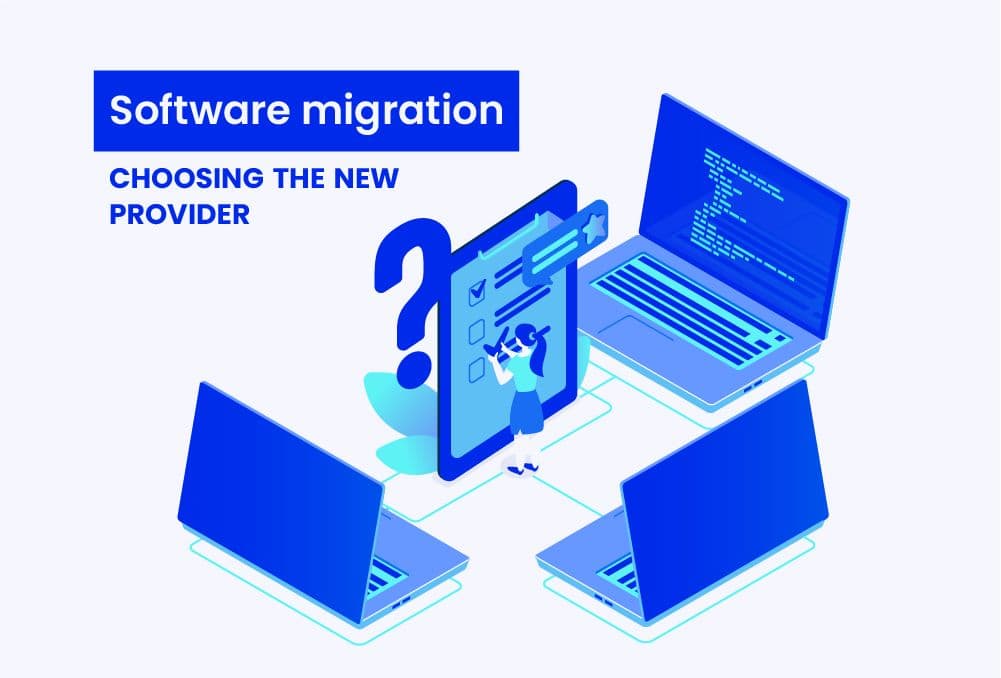Imagine managing a growing network of EV chargers across multiple regions only to find your software can't scale, your data isn’t really yours, and adding new functionality means waiting months for vendor updates.
For many Charge Point Operators and eMobility providers, this isn’t a hypothetical; it’s a daily challenge. That’s why software migration has become a critical step for forward-thinking businesses in the EV space.
Whether driven by scalability issues, interoperability needs, or ownership concerns, EV charging software migration is an undertaking that requires careful planning, especially when selecting a new provider.
In this article, we move beyond the decision to migrate and dive into how to choose the right eMobility software provider, evaluating options from both financial and strategic standpoints. We’ll look into SaaS vs licensed models, risk mitigation, customization needs, and long-term sustainability, all while keeping the unique challenges of the EV charging industry in mind.
Why migrate EV charging software in the first place?
Before diving into vendor selection, it's worth recapping why platform migration for EV charging businesses has become a pressing issue. Legacy systems often lack the flexibility needed to support new technologies, compliance with OCPP and OCPI protocols, or integrations with modern user interfaces and third-party services.
For CPOs and EMSPs operating on outdated platforms, software migration opens the door to:
- Increased platform control and data ownership
- Better customer experience via real-time insights
- Scalable and secure architecture for growing charger networks
- Enhanced compatibility with evolving EV infrastructure
Key considerations when choosing a new e-mobility software provider
When the decision to migrate has been made, the next - and perhaps most impactful - step is selecting a new software provider. This isn’t just a technical decision; it’s a strategic move that can affect operations, user satisfaction, and future scalability.
To simplify the process, we’ve divided the criteria into three essential lenses: financial, technical, and strategic.
Financial considerations: Cost structures & ROI
In the EV space, where networks scale fast and infrastructure investment is high, the financial model of your software provider becomes pivotal.
Most EV charging software providers offer solutions in the Software-as-a-Service (SaaS) model. While this offers lower upfront costs and hassle-free maintenance, it may lead to rising operational expenditure (OPEX) as your network expands. For CPOs with rapid deployment plans, this can become a long-term scalability concern.
Key questions to ask:
- Are there CAPEX options, such as a licensed model available?
- What happens to costs when the number of chargers doubles?
- Is the pricing structure transparent or tied to long-term lock-ins?
For businesses anticipating growth, a licensed EV software solution could offer a more sustainable model by providing control over deployment and custom scalability, without spiraling fees.
SaaS vs licensed software: Which model fits?
When evaluating EV charging software providers, one of the most critical decisions lies in choosing between a SaaS and a licensed software model. Each approach has distinct implications for cost, customization, scalability, and long-term control.
Software-as-a-Service model
SaaS platforms typically come with low upfront costs, making them attractive to startups or smaller operators looking for quick deployment and minimal technical overhead. These solutions include ongoing maintenance and updates as part of the package, relieving the internal team from system upkeep.
However, the convenience of SaaS often comes with recurring fees that scale with usage, meaning the more chargers you operate, the higher your operating costs become over time.
Additionally, SaaS platforms usually offer limited customization, which can restrict your ability to tailor the system to your unique business needs or integrate it with other platforms.
Licensed software
In contrast, licensed software generally requires a higher initial investment, but it can result in lower long-term costs due to minimal recurring fees. With a licensed solution, scalability costs remain more predictable, making it a sustainable choice for CPOs with expansive growth plans.
These platforms often allow for extensive customization, giving businesses greater control over system architecture, workflows, and integrations. However, maintenance responsibilities may fall partially or fully on the licensee, depending on the service agreement.
Ultimately, if your EV charging business demands agility, advanced functionality, or tight integration with third-party systems, choosing between SaaS and licensed models is about more than just pricing. It’s a strategic decision that can significantly impact your ability to scale and differentiate in the market.
Custom software for EV charging: When uniqueness Matters
Some EV charging businesses may find that neither off-the-shelf SaaS nor licensed platforms provide enough flexibility. Here, custom EV charging software becomes a viable solution.
With a tailored platform, CPOs can:
- Design software to mirror internal workflows
- Add features like dynamic pricing, smart load balancing, or renewable energy integration
- Differentiate in a competitive market
While custom development can demand higher upfront investment and longer deployment timelines, it often pays off in competitive positioning and future-proofing.
Mitigating risks during software migration
Migrating your emobility software isn’t without its risks. Downtime, incompatibility, or data integrity issues can cause operational disruptions. Here are the key areas to focus on when vetting providers:
1. Downtime and service disruption
Ensure the provider has rollback mechanisms, testing environments, and data migration strategies to keep charging stations operational during the switch.
2. Data ownership and privacy
Data is critical for monetization and user experience. Avoid platforms where ownership remains with the vendor. Consider proprietary or licensed models for full autonomy.
3. OCPP/OCPI compatibility
The provider should offer seamless support for standard protocols, ensuring interoperability with your existing infrastructure.
4. Security
Evaluate the provider’s compliance with data protection standards and history of security incidents.
Criteria checklist: Choosing the right EV software vendor
Use the following criteria to assess potential providers:
✅ Demonstrated experience in EV charging software migration
✅ Modular and scalable architecture
✅ Transparent business model (SaaS, licensed, hybrid)
✅ Data ownership and GDPR-compliance
✅ Robust support and SLAs
✅ Proven track record in working with CPOs or EMSPs
Solidstudio’s experience in EV software migration
At Solidstudio, we’ve partnered with numerous Charge Point Operators (CPOs) and eMobility Service Providers (EMSPs) to help them migrate from outdated systems to modern, scalable, and interoperable EV software platforms.
From SaaS and licensed model deployments to fully customized CPMS solutions, we specialize in aligning software architecture with operational and strategic goals, always with a strong focus on reliability, speed, and zero service disruption.
Real-world impact: migrating 9000 sockets with zero downtime
One standout example is our ongoing collaboration with Connected Kerb, a leading UK-based CPO known for its extensive on-street EV charging network. In late 2023, Connected Kerb approached us with a challenge: migrate their existing CPMS to Solidstudio’s licensed CPO platform, while maintaining uninterrupted service for over 9000 charging sockets.
Key highlights from the project:
- Zero downtime across 9000 EV charge points
- Seamless transition of their CPMS from AWS to Azure to align with internal IT infrastructure
- OCPP and OCPI compatibility testing to maintain partner integrations
- Integration with Connected Kerb’s existing EMP system and mobile app
- Ongoing custom development and production monitoring in line with SLA agreements
What made this project especially complex was the need to migrate not just the backend platform but also ensure full interoperability with mobile users, OCPI partners, and Azure-native services, all while optimizing workflows for the customer care team and preserving system reliability.
Our process included an in-depth discovery phase, collaborative roadmap alignment, and phased rollout with pilot migrations followed by full-scale deployment. Solidstudio’s technical team embedded directly into the client's operations, aligning with their Teams communication channels and DevOps workflow.
The result? A strategic migration executed with precision, resilience, and long-term flexibility, ensuring Connected Kerb remains at the forefront of scalable, future-ready EV infrastructure.
Ready to migrate with confidence?
From custom EV charging software to licensed platform implementation, Solidstudio delivers tailored solutions backed by real-world success stories and deep industry insight.
We believe that migration doesn’t have to be risky. With a structured process and deep sector expertise, it becomes a strategic enabler for innovation, data ownership, and user satisfaction.
If you're preparing for a software migration and want to minimize risk while maximizing value, we're here to help.
Book a free consultation with one of our EV software migration experts today and take the first step toward a more powerful, scalable platform.

